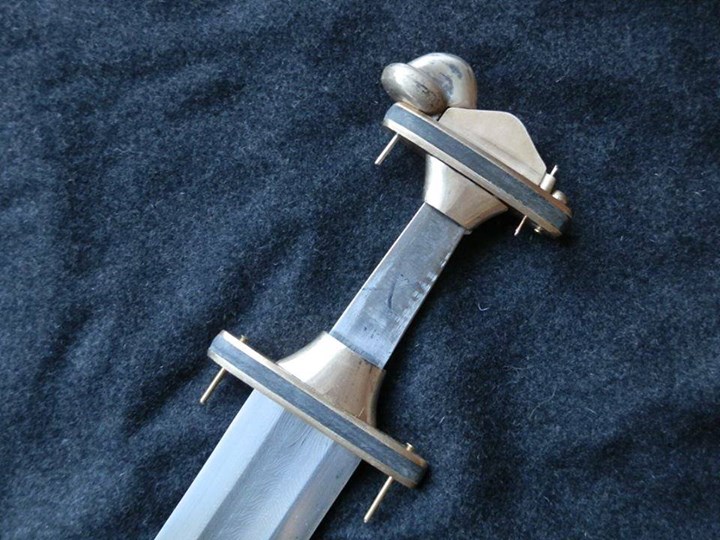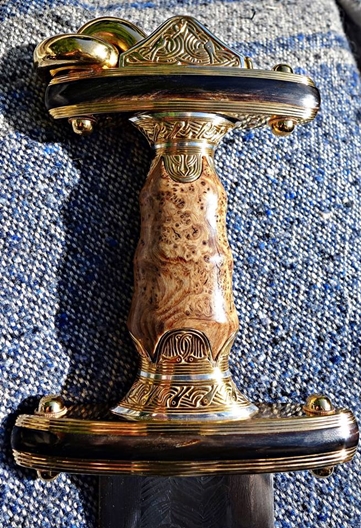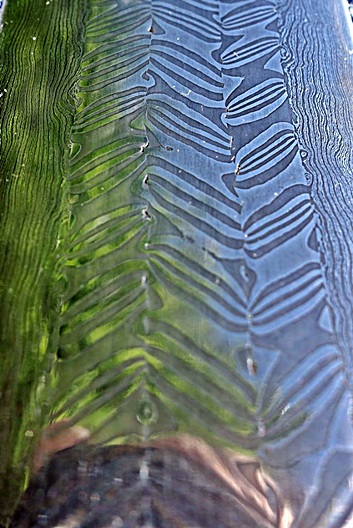Posts: 10 Location: Maine
Fri 17 Jul, 2015 7:13 am
Why were so many hilts designed like this?
I have seen a number of swords from the migration period that have this sort of hilt (picture attached).
First, it appears that something is sandwiched between two plates on either end. Is that leather? Antler? I've seen what appears to be different materials there.
Second, they always seem to have that little knob on one side of the pommel.
Can anyone describe the reasons for these designs?
Thanks!
 Attachment: 107.76 KB
Attachment: 107.76 KB

Posts: 1,084 Location: Finland
Fri 17 Jul, 2015 9:18 am
Re: Why were so many hilts designed like this?
| Sean Page wrote: |
I have seen a number of swords from the migration period that have this sort of hilt (picture attached).
First, it appears that something is sandwiched between two plates on either end. Is that leather? Antler? I've seen what appears to be different materials there. |
It's usually something organic, like antler, bone or wood, but I don't think leather - or identifiable remains thereof - has ever been found in this particular context. Sometimes all the layers are metal. It seems to be mainly a fashion choice, although ease and cost of manufacture probably plays a role in the popularity of organic materials.
| Quote: |
Second, they always seem to have that little knob on one side of the pommel.
Can anyone describe the reasons for these designs? |
It's a decorative element, a representation of a ring fixed to the pommel by a U-shaped rivet.
As far as I know, this probably stems from precious rings being common gifts from rulers to their favored men, to the extent that "ring-giver" was a popular euphemism or kenning for "king". At some point somebody thought to fix such a gift to the hilt of their sword for convenient and conspicuous display; at some likely not much later point, someone else made one of the rivets that hold together the sandwiched upper guard into a U-shape and hung a ring from that; and even later someone came up with the idea of decorating a hilt with the sort of slightly abstracted representation of a U-shaped rivet and ring that you see here.
Posts: 10 Location: Maine
Fri 17 Jul, 2015 10:01 am
Thanks, Mikko, that is interesting.
The ring description is certainly plausible. I can't see any functional reason for it. I don't personally care for the asymmetrical look it gives, though.
Ok, so for the sandwiched plates. It seems surprising that it would only have aesthetic purposes. I thought it might have something to do with helping the tightening of the plates on either side by providing some give. I thought the design of the plates with their screws had something to do with how the grip and/or hilt was secured to the blade.
Posts: 1,462 Location: Laurel, MD, USA
Fri 17 Jul, 2015 10:47 am
I suspect the sandwiched hilt construction developed originally from all-organic hilts that sometimes had metallic spacers or plates added. So the *metal* parts are the addition, not the organic. The example you show is not complete, since the grip is missing and the rivets have yet to be cut to length and peened flat. There aren't any "screws", as we know them!
An awful lot of hilt construction is based on fashion! There just was not really much need for any functional differences, for a long time.
Matthew
Posts: 483 Location: Somerset UK
Fri 17 Jul, 2015 3:31 pm
| Matthew Amt wrote: |
I suspect the sandwiched hilt construction developed originally from all-organic hilts
Matthew |
The vast majority of swords throughout the Anglo Saxon pagan period have no surviving hilt fittings, presumably because they were entirely organic (horn being the material of preference).
The metal additional plates occur in a number of configurations (a single one on the lower face of both the upper and lower guard, a proper sandwich on just the lower guard, proper sandwich on both guards and at least one example where both guards are completely enclosed within iron plates.
The ring you show is a Type 2.
Type 1 ring hilts have a ring which actually moves in the staple. Type 2 ring hilts have fixed rings and Type 3 are one piece castings that don't even look like separate rings any more.
Nobody really knows what they represent but the most popular theories revolve around the idea of the Anglo Saxon king as a giver of rings. Either the rings themselves are gifts (some pommels show signs of having been modified to accept rings) or that the sword with ring pommel is a gift from the king and a symbol of the service and loyalty owed by the recipient.
Here's mine...
 Attachment: 255.39 KB
Attachment: 255.39 KB

Posts: 10 Location: Maine
Sat 18 Jul, 2015 8:26 am
Beautiful!
Looking at the patterns on the blades, the one with no ring has a very random pattern, while the one with the ring has the pattern just in the fuller and appears to run more parallel down the blade.
What is the difference between the two? Is the ring sword using pattern welding and the non-ring sword using Damascus?
Posts: 589
Sat 18 Jul, 2015 9:50 am
General inquiry: can anyone tell me the source/maker of the WIP sword in the original post? I'm curious to see who is doing that reproduction, and to see more pictures of it.
And now back to the regularly scheduled program.
Posts: 99 Location: Saskatoon SK Canada
Sun 19 Jul, 2015 4:41 am
An additional explanation I have heard for the rings on swords is that in pagan Scandinavia / Germany it was customary to swear oaths on a ring. Specifically, the arm-ring of office of the local godi or high-priest. Conveniently, most Norse chieftains were not only the local ruler but also the local godi, so when you swore loyalty to them as one of their warriors, you took your oath on their arm ring as both chieftain AND godi.
Later, a fashion developed of attaching the oath ring to the sword hilt. You thus took your oath to your chief/godi by placing your hand on his sword hilt. I might be wrong about this, but my general impression has been that the ring swords are almost universally high status weapons.
This may also be the source of the entire notion of "taking sword oath", swearing "on your sword" or "by your sword" and generally having honour bound up in the sword (and, for that matter, why a knight was later dubbed with a sword?) -- the original sacred artifact was the oath-ring attached TO the sword, and the ritual importance later spread to the entire weapon itself.
For that matter, has anyone ever tried to see if there is any developmental link between the Migration and Viking era swords with rings riveted to the hilts and those slightly later Irish swords with ring pommels?
Posts: 1,220 Location: Cork, Ireland
Sun 19 Jul, 2015 3:37 pm
| John Hardy wrote: |
| For that matter, has anyone ever tried to see if there is any developmental link between the Migration and Viking era swords with rings riveted to the hilts and those slightly later Irish swords with ring pommels? |
I wouldn't call the Irish ring pommelled swords "slightly" later that migration era ring hilted swords. One type was ppopular in the 6th and 7th centuries, while the other was from the 16th. There is no evidence of a connection between the two.
Posts: 99 Location: Saskatoon SK Canada
Sun 19 Jul, 2015 6:00 pm
| Stephen Curtin wrote: |
| John Hardy wrote: | | For that matter, has anyone ever tried to see if there is any developmental link between the Migration and Viking era swords with rings riveted to the hilts and those slightly later Irish swords with ring pommels? |
I wouldn't call the Irish ring pommelled swords "slightly" later that migration era ring hilted swords. One type was ppopular in the 6th and 7th centuries, while the other was from the 16th. There is no evidence of a connection between the two. |
Did the Irish ones only start showing up in the 16th? They aren't anything I have ever researched myself but i had the impression they started around the time the Vikings were occupying parts of the country. Apparently not...
Posts: 1,084 Location: Finland
Mon 20 Jul, 2015 11:19 am
| Sean Page wrote: |
Beautiful!
Looking at the patterns on the blades, the one with no ring has a very random pattern, while the one with the ring has the pattern just in the fuller and appears to run more parallel down the blade.
What is the difference between the two? Is the ring sword using pattern welding and the non-ring sword using Damascus? |
Neither of these has anything to do with "Damascus steel", which was a form of crucible steel imported to Europe from India through Damascos, hence the colloquial name; it's more properly called wootz.
What you see here is called pattern welding, i.e. several rods of varying grades of iron/steel are twisted around each other and forge-welded together to produce a single piece, which is then usually lightly etched to accentuate the visible pattern formed by the different metals. You can produce surprisingly precise patterns by carefully varying the way you twist and fold the rods. The pattern on the Mad Dwarf sword does seem larger and more chaotic than the others, but it is there, and if we saw more of the blade I assume we'd see it repeating several times along its length with some random variations each time.
Originally pattern welding was a method of regulating the carbon content and other impurities (some desired, some not) and thus the structural qualities of the steel - it's the same principle as with Japanese folded steel - but ever since we learned to make monosteel, i.e. steel with a homogenous metallurgical make-up throughout, like on the famous Ulfberht swords from the late Viking age, it really just looks cool.
The first three swords posted to this thread (including the one you posted, though it hasn't been etched and polished yet) all have a pattern-welded core, with edges made of a separate piece of harder steel welded onto it, as does the historical artifact David posted; Mad Dwarf's sword has the entire blade made of the pattern-welded material.
Posts: 483 Location: Somerset UK
Mon 20 Jul, 2015 1:39 pm
| Mikko Kuusirati wrote: |
The first three swords posted to this thread (including the one you posted, though it hasn't been etched and polished yet) all have a pattern-welded core, with edges made of a separate piece of harder steel welded onto it, as does the historical artifact David posted; Mad Dwarf's sword has the entire blade made of the pattern-welded material. |
Just to clarify, the cutting edge of mine (a reconstruction of the Valsgarde 8 sword by Vince Evans) is also patterned, as you can see from this close up.
As (I believe) does the Bildsų sword.
 Attachment: 99.08 KB
Attachment: 99.08 KB

 Attachment: 91.22 KB
Attachment: 91.22 KB
[ Download ]
Posts: 1,084 Location: Finland
Mon 20 Jul, 2015 2:00 pm
Ah, yes, sorry - what I was trying to say is that the Mad Dwarf blade seems to be made from one piece of patterned steel, while the others have separate pieces of different steel for the edges, also pattern welded but in a different pattern from the core. You can see this on the WIP sword Sean posted, too.
Posts: 1,220 Location: Cork, Ireland
Mon 20 Jul, 2015 5:30 pm
| John Hardy wrote: |
| Did the Irish ones only start showing up in the 16th? They aren't anything I have ever researched myself but i had the impression they started around the time the Vikings were occupying parts of the country. Apparently not... |
The only evidence available to us at present, indicates that Irish ring pommelled swords are from the 16th century. Personally I suspect that they may have started in the late 15th century, but that's just speculation.
Posts: 506 Location: NC
Tue 21 Jul, 2015 1:08 pm
Scott put this page together that documents the construction of my sword.
http://www.bigrockforge.com/migration-period-ring-sword/
[ Linked Image ]
[ Linked Image ]
Posts: 53 Location: Utah
Tue 21 Jul, 2015 2:02 pm
The ring may have been a saddle ring, for attaching to your saddle so it does not fall off. This feature is present on many firearms as well, though probably not from that period.
Posts: 1,084 Location: Finland
Tue 21 Jul, 2015 6:14 pm
| Alexander Ehlers wrote: |
| The ring may have been a saddle ring, for attaching to your saddle so it does not fall off. This feature is present on many firearms as well, though probably not from that period. |
Maybe, but not likely. It may have been used for attaching a wrist lanyard, but even that is almost pure speculation: there are lots of references to people having their swords hanging from their wrists in somewhat later textual sources, both to prevent losing the sword and to temporarily free the hand for other tasks like throwing a spear, but I can't recall a single mention of ring hilts in the same immediate context.
Posts: 10 Location: Maine
Tue 21 Jul, 2015 6:24 pm
Picturing a sword swinging from my wrist on a lanyard while I throw a spear... Not thinking that would be the best way to go.
Posts: 483 Location: Somerset UK
Tue 21 Jul, 2015 11:35 pm
| Alexander Ehlers wrote: |
| The ring may have been a saddle ring, for attaching to your saddle so it does not fall off. This feature is present on many firearms as well, though probably not from that period. |
Type 2 & 3 'rings' are solid, with no means of passing anything through them.
You
cannot post new topics in this forum
You
cannot reply to topics in this forum
You
cannot edit your posts in this forum
You
cannot delete your posts in this forum
You
cannot vote in polls in this forum
You
cannot attach files in this forum
You
can download files in this forum


